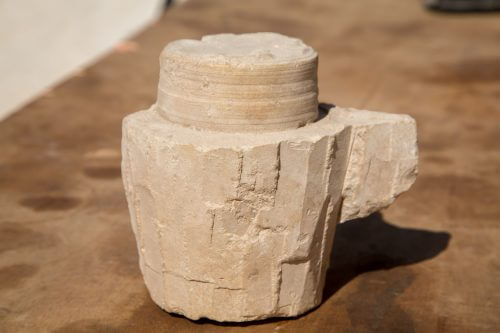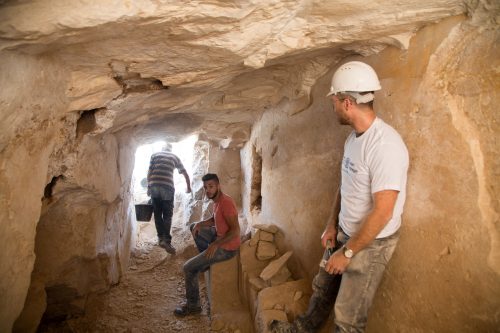The discovery is a fascinating testimony to the importance that the Jews of the Galilee attached to observing the laws of impurity and purity 2000 years ago. There are only four such manufacturing houses known in Israel, two in the Galilee and two in the Jerusalem area

A rare workshop for the production of stone masonary vessels, dating back to the Second Temple period, was uncovered in recent days in an archaeological dig in Kfar Rayna in the Lower Galilee. The excavation reveals a quarry containing thousands of grains (blocks) of Kirton stone, which were waste from the maker's house, as well as mugs and bowls in various production processes. The ancient site was uncovered during development work by the Reina local council in preparation for the construction of a sports hall in the village, when the carved limestone cores emerged on the surface. This is the fourth creator's house of its kind to be discovered in Israel; Another workshop was uncovered these days in Ainat Amitai, one kilometer away from the current workshop. The other two known workshops from the Second Temple period were discovered far from here - in the Jerusalem area, decades ago.
According to Dr. Yonatan Adler, a senior lecturer at Ariel University and the director of the excavation on behalf of the Antiquities Authority, who studied the Jewish use of stone tools in the Roman period, "the new discovery confirms the knowledge of the great importance that the Jews of the Galilee attached to the observance of the laws during the period when the Temple in Jerusalem operated. The stone tools are a clear characteristic of the Jewish population, because they were considered to not receive impurity. The appearance of stoneware in the Jewish settlements stands out, against the background of the fact that the prevailing practice in ancient times was to make tableware and storage out of clay." According to Dr. Adler, "Unlike pottery, which when exposed to impurity had to be broken and taken out of use, the stone vessels remained pure. Therefore, the Jews made sure to keep some special stone tools at home. These tools are known on many Jewish websites, but to find the place where Produced These tools are extremely rare. These days, another workshop is being discovered at the site of Ainat Amitai - about a kilometer from this site. So far, we have known only two similar workshops, and both were uncovered in the Jerusalem area. Now we are exposed to the power of keeping the laws of impurity and purity in the Galilee region as well."

The excavation revealed a kind of artificial tunnel cut by the stone masons, from which the cardboard material for the production of the tools was extracted using iron chisels. On the sides of the small tunnel, the signs of quarrying are visible. Scattered on the surface are thousands of stone cores, which are, in fact, waste from the tools. Many unfinished tools were also found that were thrown in the field, after apparently being discarded in the production process. According to Dr. Adler, "According to the waste, many mugs with handles and bowls of various sizes were created here. The finished vessels were sold to all the settlements of the Galilee, where the Jewish residents were strict about the rules of purity. The observance of purity was very common among the Jews in Jerusalem and in the Land of Judah during the time when the Temple was active in Jerusalem, and at least until the failure of the Bar Kochba Revolt in 135 AD. The new discovery may provide a solution to the question - until when the rules of purity were kept among the Jews of the Galilee."
Jordana Alexander, an archaeologist at the Israel Antiquities Authority who studies the Galilee during the Roman period adds, "Over the years we have found parts of these stone tools in excavations alongside pottery in excavations of houses in Jewish villages and cities from the Roman period, for example in Kfar Cana, Tzipori and Nazareth. Now, for the first time, there is an extraordinary opportunity to investigate their place of production in the Galilee." According to her, "evidence of the importance of keeping the laws of purity is mentioned in the Mishnah and the Talmud, and also in Christianity: in the Gospel according to John in the New Testament, it is said that Jesus and his mother Miriam were invited to a Jewish wedding in "Cena Asher in the Galilee", where they served wine. When the drinking ran out, Jesus ordered to fill six jars made of stone with water "according to the purification customs of the Jews", and the water in them turned into fine wine. Thus, according to the New Testament, the virtues of Jesus were noticed for the first time." According to Alexander, "The two workshops that were excavated in the last few months are very close to Kfar Cana, the place identified by many with "Cana that is in Galilee" from the Christian tradition. It is very possible that large vessels made of stone, of the type described in the Christian story, were made in a workshop similar to the ones that have just been discovered."

2 תגובות
The Galilee was inhabited by Jews during the Second Temple period.
I did not see but Jewish signs on the dishes. No reason to see, but again, in mathematics I have to prove a claim.
The claim here is Jews. You have to reason why.
I didn't understand and I apologize if I missed it. Where is it written and how do you know that it is identified with Jews in the Second Temple apart from the fact that in the days of the Second Temple the majority were Jews.